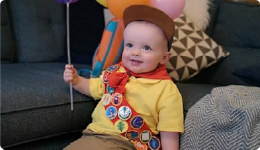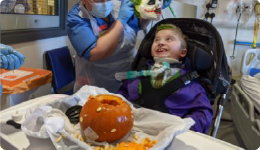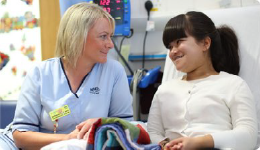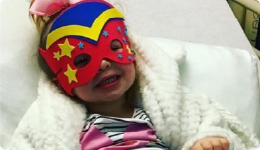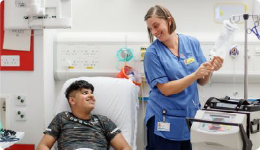As your child grows and develops they will start to become more independent with bathing and grooming. They will probably need reminders and supervision for safety until primary 6 or 7. By the time they are getting ready to go to secondary school they might be more interested in their appearance and take more care over this.
Bathing Independently
To help your child become independent with washing there are lots of things that you can try.
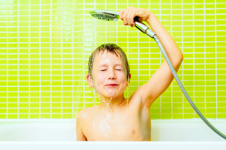 Have a consistent routine for bathing/showering
Have a consistent routine for bathing/showering
- Have your child bathe/shower on the same days each week, aim to do it at a similar time such as before school or as part of the bedtime routine.
- Wash or get them to wash their body parts in the same order each time.
- Make sure your child is safe in the bath or shower. Have a non-slip mat on the floor. Show them how to test the temperature of the water.
- Sitting down in the bath or shower can be easier as your child doesn't have to worry about balancing.
- Teach one step at a time like opening the shower gel or shampoo, washing their face, drying their body.
- Use visual checklists to help your child with remembering the steps of the task. Have the pictures in a place that your child can see them such as laminated and on the wall of the shower. Remind your child to look at the next picture in the sequence rather than telling them what to do.
- Modify the task:
- If twisting the lid off the shower gel is hard use a bar of soap.
- If they find the feel of the shower uncomfortable or painful can they wash at the sink?
Hair Care
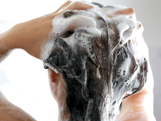 Hair care involves lots of different things including brushing/combing, cutting and washing and drying. If hair care is difficult for your child talk to them about why this is and what might help. This could help you to work out which strategies might work best for your child/young person. If they can't tell you then you might need to work as a detective to make a best guess and use trial and error to find the strategies that work best.
Hair care involves lots of different things including brushing/combing, cutting and washing and drying. If hair care is difficult for your child talk to them about why this is and what might help. This could help you to work out which strategies might work best for your child/young person. If they can't tell you then you might need to work as a detective to make a best guess and use trial and error to find the strategies that work best.
Modify the task:
- Think about how you can make the task easier. If your child dislikes having their hair brushed then keeping hair short or tied back/plaited means less brushing. If they don't like water in their eyes or ears can they use ear plugs or goggles. If they don't like shampoo try different types (liquid/gel, solid bar, dry/powder), different scents or unscented products to find something they like.
- Try different tools: hairbrushes/combs including long-handled varieties, hairdryers, hair straighteners microfibre towels, hair clippers/razor, scissors, hair dryer stand or clamp.
- Try different products liquid, solid bar, dry shampoo, conditioning bar, cream, detangling spray, leave in products, unscented products.
- Experiment with shower versus the bath for washing hair. If you have a shower over the bath try taking the detachable hose off the hook and using it on right on your child's head.
- Get them to sit down so they don't have to balance and do the task.
- Teach one step at a time. Use the backward chaining method.
- Get your child/young person to watch videos of how to do the task.
Make it predictable:
- Set rules around how often, where, when and how you do these tasks.
- Have a routine so that it happens in the same way every time.
- Try using visual timetables like now and next, or a sequence chart or a visual timer so they know when it will finish.
- Use distraction if you need to - watch a favourite cartoon or video.
- Get them to do it themselves - being in control can make it easier to tolerate.
- Keep all your child/young person's tools/products in one place.
Think about the environment:
- Make sure the environment is safe, use a non-slip mat in the bath/shower, supervise your child around water, teach them how to test the temperature of the water, to keep their hands away from scissors etc.
- Use a mirror so they can see what is happening and what are they doing.
- Go to the barbers or hairdresser at quiet times. Getting to know the barber/hair dresser and visiting even when not getting a hair cut can be helpful for some children/young people.
- Reduce other sensory demands - if your child doesn't like the feel of a hair cut, reduce noise, turn the lights down etc.
Managing Periods
Prepare your daughter well in advance of her starting her periods:
- Read books together about the changes to her body (see resources below)
- Show your daughter the different types of sanitary products. There are lots of options out there, disposable/reusable sanitary towels and tampons, menstrual cups and period pants. Talk about what would work best for her. Sanitary towels and period pants are usually a good starting point.
- Once you have decided what will work best, practice using them. Practice all the steps. Remember to practice opening the product, putting it in/out of pants and disposing of it appropriately. Practice until they are confident with all the steps.
- Some people need pictures to help them understand what to do. There are some resources below. Some products also have pictures in the instructions. You may need to put the pictures beside the toilet to remind her what to do.
- Many girls and women find period pants to be more comfortable. They are particularly useful for anyone who physically struggles with putting in and taking out a sanitary towel or for people who have difficulty managing each step in the right order.
- Have your child practice wearing pads or period pants from time to time before starting their periods, to get used to how it feels. Start with just a minute or two and gradually build up over time.
- Talk about hygiene with your daughter. Talk about the importance of changing their pads/pants every few hours, showering daily, washing their hands before and after going to the toilet.
- Keep a bin close to the toilet for your daughter to dispose of used pads/tampons. If using reusable products make sure she has somewhere to put them before until they are ready to be washed (a wet/wash bag or specific bin/bucket with a lid).
- In public toilets show your daughter the sanitary disposal bin and how it works. Explain that this is where used sanitary towels and tampons go. Tell your daughter these will be in the school toilets.
- When your child first starts their periods they may have accidents, or get blood on their hands, the floor or clothes. Reassure your child that this is normal. Keeping a small pack of baby wipes with their sanitary pads will help with any clean up. A change of pants/trousers and fresh pads in their school bag may also be necessary. Practise cleaning up and changing at home. Teach your child to put used wipes in the bin. Do not flush wipes or sanitary products down the toilet.
- Help your child keep track of her/their periods by marking on a calendar when they start and end. This will help your daughter learn to predict when her next period is due so that she are prepared and has period products with her.
- Remember to take a bag with a change of clothes and sanitary products to any clubs or activities.
Sensory Aspects of Periods
The onset of periods can be particularly challenging for some neurodivergent young people or others who have heightened sensory awareness. Periods involve a lot of new sensory experiences including:
- the feeling of blood leaking from the vagina
- the smell of the blood or the sanitary products (either when new or used)
- the look of blood in pants or on toilet paper
- the feeling of the sanitary towel or period pants
- the fear of touching the blood
- the feeling of stomach cramps, sore breasts or other hormone related body changes.
Your child may not be able to identify what is making them feel uncomfortable or distressed so trial and error may be required to get to the bottom of it.
Experiment with hygiene products: different brands of sanitary towels, menstrual cups, tampons and period pants, to find what is most comfortable and preferred. If appropriate for your child, treat it as a science experiment or adventure where records are kept of what has been tried, what the outcome was (good things and bad things about each product) and what is next.
Changing towels, tampons, or pants more frequently may help reduce the smell. A perfume or body spray that your child likes may help cover smells. Many disposable sanitary products are perfumed. If this is an issue, then look for unscented products or reusable products.
Using disposable gloves may reduce anxiety about touching blood – gloves that fit well are easier to use.
Have wipes available – teach your child not to flush wipes down the toilet, dispose of them in the bin.
If your child is afraid or anxious about blood, you may need to prepare them well in advance, using pictures such as those included in the resources below.
If your child is struggling with severe pain, heavy periods or mood swings, discuss with your GP what would be helpful to manage these symptoms.
This information uses the terms daughter, girl, woman, she. We acknowledge that not all people who get periods identify with these terms.
Resources:
Nail Care
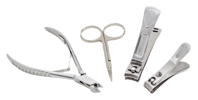 Some children/young people have difficulty tolerating having their nails cut. Start by talking to your child/young person about what it is they don’t like about nail care. This will help you to work out which strategies to try. If they can't tell you you will need to be a detective and make a best guess about what your child/young person is finding distressing and use trial and error to find the strategies that work best.
Some children/young people have difficulty tolerating having their nails cut. Start by talking to your child/young person about what it is they don’t like about nail care. This will help you to work out which strategies to try. If they can't tell you you will need to be a detective and make a best guess about what your child/young person is finding distressing and use trial and error to find the strategies that work best.
Here are some suggestions for you to try with your child:
- Try different tools: nail scissors (curved or straight), nail clippers, nail file. You might need to experiment with a few different things before finding what is most comfortable for your child. Some children take a little while to adapt to new sensations so try to use a new tool 4 or 5 times before trying the next thing.
- Use visual supports like now and next to help your child understand what is happening.
- Try cutting or filing nails after a bath when your child’s nails are a bit softer.
- Break the task down into tiny steps and do one steps at a time. For example, just cut one nail.
- Use distraction: Let them watch a favourite programme or video, sing a song together, play with a toy or listen to music while you cut their nails.
- Sometimes it can be easier to tolerate nail care if your child/young person can cut or file their nails themselves. Teach them how to do it themselves and teach them how to do it safely.
Teeth Brushing
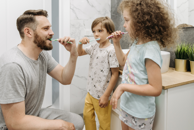 Brushing your teeth is an essential part of looking after your body. Your child should be brushing their teeth at least twice a day. They will need help from you until they are 7 years old. You can find out more from:
Brushing your teeth is an essential part of looking after your body. Your child should be brushing their teeth at least twice a day. They will need help from you until they are 7 years old. You can find out more from:
 Teach your child to start buttoning at the bottom of a shirt. It is easier to line up the bottom to make sure the buttons and holes match.
Teach your child to start buttoning at the bottom of a shirt. It is easier to line up the bottom to make sure the buttons and holes match.


 Every family's mealtime is different. Some families sit at a dining room table, others kneel at a low table, some families sit on the sofa and some families eat at different times. Some families use cutlery and others eat with their hands. Whatever works for your family is best for your child.
Every family's mealtime is different. Some families sit at a dining room table, others kneel at a low table, some families sit on the sofa and some families eat at different times. Some families use cutlery and others eat with their hands. Whatever works for your family is best for your child. 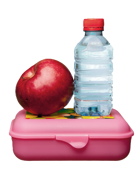 make sure it is big enough to hold lunch and snack with extra room to make it easy to put everything away when your child is finished
make sure it is big enough to hold lunch and snack with extra room to make it easy to put everything away when your child is finished There are different things to think about when your child has school meals.
There are different things to think about when your child has school meals. Have a consistent routine for bathing/showering
Have a consistent routine for bathing/showering
 Hair care involves lots of different things including brushing/combing, cutting and washing and drying. If hair care is difficult for your child talk to them about why this is and what might help. This could help you to work out which strategies might work best for your child/young person. If they can't tell you then you might need to work as a detective to make a best guess and use trial and error to find the strategies that work best.
Hair care involves lots of different things including brushing/combing, cutting and washing and drying. If hair care is difficult for your child talk to them about why this is and what might help. This could help you to work out which strategies might work best for your child/young person. If they can't tell you then you might need to work as a detective to make a best guess and use trial and error to find the strategies that work best. Some children/young people have difficulty tolerating having their nails cut. Start by talking to your child/young person about what it is they don’t like about nail care. This will help you to work out which strategies to try. If they can't tell you you will need to be a detective and make a best guess about what your child/young person is finding distressing and use trial and error to find the strategies that work best.
Some children/young people have difficulty tolerating having their nails cut. Start by talking to your child/young person about what it is they don’t like about nail care. This will help you to work out which strategies to try. If they can't tell you you will need to be a detective and make a best guess about what your child/young person is finding distressing and use trial and error to find the strategies that work best.  Brushing your teeth is an essential part of looking after your body. Your child should be brushing their teeth at least twice a day. They will need help from you until they are 7 years old. You can find out more from:
Brushing your teeth is an essential part of looking after your body. Your child should be brushing their teeth at least twice a day. They will need help from you until they are 7 years old. You can find out more from: Ask to go to the toilet
Ask to go to the toilet
